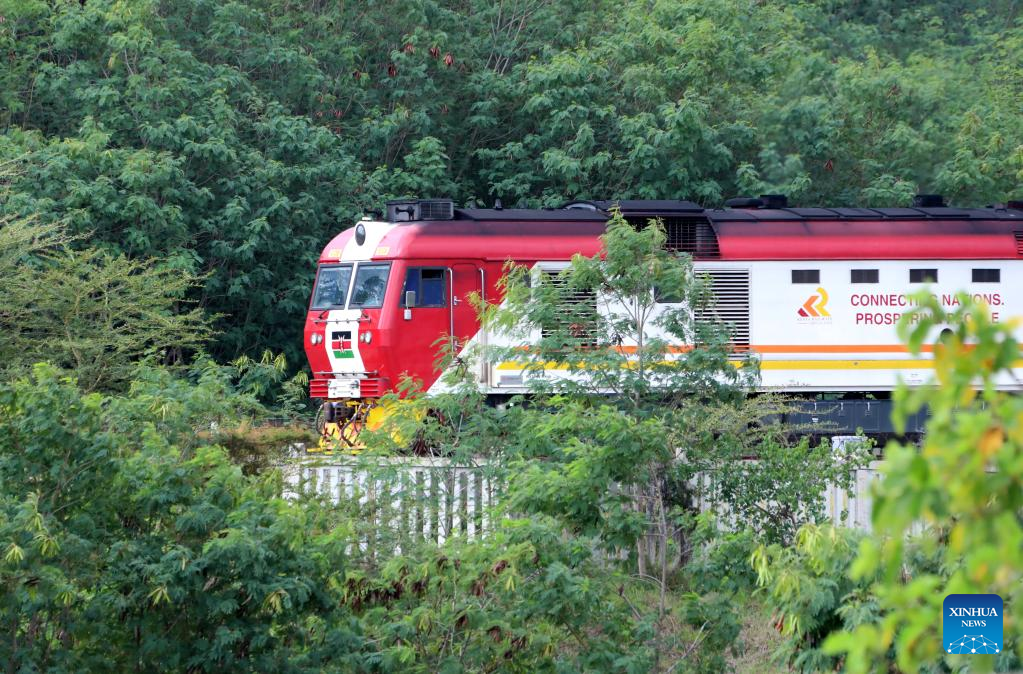Chinese built railway an economic game-changer for Kenya

A freight train runs on the Mombasa-Nairobi Railway track in Mombasa, Kenya, on July 27, 2022. (Xinhua/Dong Jianghui)
Kenya’s 480-km Standard Gauge Railway (SGR) which was officially launched by President Uhuru Kenyatta on May 31, 2017, has ushered in a new era in Kenya’s national development, as it is the single most expensive infrastructural project in Kenya’s history. The SGR was highlighted as a key project in Kenya under the Belt and Road Initiative (BRI). The BRI was envisaged as a vehicle for achieving infrastructure, policy, trade, financial and people-to-people connectivity to create new drivers of shared development.
According to data released by the Kenya National Bureau of Statistics (KNBS) on July 6, the SGR passenger train moved some 7.78 million passengers between Nairobi and Mombasa since its inception in June 2017. In 2021 the Chinese-built train carried the highest number of passengers at 2 million passengers, with 2018 coming second at 1.67 million passengers ferried.
Further, KNBS said the SGR ferried 699,055 passengers in 2017, 1.59 million passengers in 2019, and 1.29 million passengers in 2020. Using the modern rail service, this massive movement of people proved Madaraka Express is a display of increasing popularity of the SGR.
Reducing travel time for passengers from Nairobi to Mombasa from an average of 10 hours to only five, the SGR is the biggest Chinese project yet in Kenya. Conceived by President Kenyatta and President of the People's Republic of China, Xi Jinping, when they jointly witnessed signing of the memorandum of understanding on financing the Mombasa-Nairobi SGR Project on August 19, 2013, the building of the SGR was necessary.
First, the old railway technology and system had become an outmoded meter gauge railway with low speeds, obsolete facilities, and low payload. This state of affairs was gradually hampering transportation of people and goods between the two most economically significant destinations in the country.
Alongside numerous other investments in key infrastructure projects (energy, roads, water) that drive investment, SGR is putting Kenya on the path to industrialization, especially in manufacturing and value addition, which will ultimately improve the country’s import/export ratio through Mombasa and Lamu ports.
The most immediate impact of SGR includes reliable and high-capacity transport, reduced freight cost, decongested roads leading to savings in road maintenance, decongested ports, skills transfer, and an increase in employment opportunities, directly and indirectly, through industries that are coming up along the railway line development.
The SGR is in line with the East African Railway Master Plan, which aims to rejuvenate existing railways serving Tanzania, Kenya and Uganda, extending them initially to Rwanda and Burundi, and eventually, to South Sudan, Ethiopia and beyond. SGR is also a Kenya Vision 2030 project, which places efficient transportation as a major enabler of both national and regional development.
Goods going to the East Africa hinterland countries of Uganda, Rwanda and Burundi will be cheaper due to decreased transport costs and faster arrival to their destinations. Taking at least two days for trucks to reach Kampala from Mombasa, this could be shortened to just one day once the railway reaches Kisumu. It will also make integration of the EA Community a reality with the easy movement of people within the region.
According to the President’s Delivery Unit (PDU), the SGR is a modern, efficient transport system that is enabling safe, comfortable travel for individuals and freight across the country and region at lower costs.
SGR’s impact has also reached the “common man” in terms of being a cheap and efficient channel to do business, and has proved to be the economic game changer it was touted to be at both the national and local levels.
Kenya’s Big Four programme, that has left the signature legacy projects for President Kenyatta, have enjoyed significant support from China as part of the programs under the framework of Forum on China-Africa Cooperation between Kenya and China. The two countries will continue to cooperate on both bilateral and global issues including peace and security, health, climate change, and blue-green technology transfer and circular economy.
In a telephone conversation with Kenya's Cabinet Secretary for Foreign Affairs Raychelle Omamo on June 15, Chinese State Councilor and Foreign Minister Wang Yi reiterated China’s willingness to continue working closely with one of its major African bilateral partners.
China is ready to work with Kenya to firmly advocate and practice multilateralism, safeguard the common interest of developing countries, and uphold the basic norms governing international relations, Wang said, adding that the Chinese side looks forward to Kenya's participation in the Global Development Initiative.
Wang told his counterpart that he hopes Kenya will ensure the safety of Chinese institutions, projects and personnel in the country. Indeed, this is significant, particularly in this election year when political passions run high. Still, Kenya remains a haven of peace for foreign nationals with a soft centre for China due to the positive outcomes of the deepening partnership.
The author is the Executive Director of South-South Dialogues, a Nairobi based research and development communication think tank.
The opinions expressed in this article reflect those of the author and do not necessarily reflect those of People's Daily Online.
Photos
Related Stories
- Chinese-built modern railway leads to brighter future for Kenya
- Chinese-built SGR set to streamline Ethiopia's export, boost profitability
- “I feel proud to stick to my job on the railway artery”
- Kenya's SGR phase 2A project launches test run
- Kenya launches flagship standard gauge railway set to transform nation
Copyright © 2022 People's Daily Online. All Rights Reserved.









